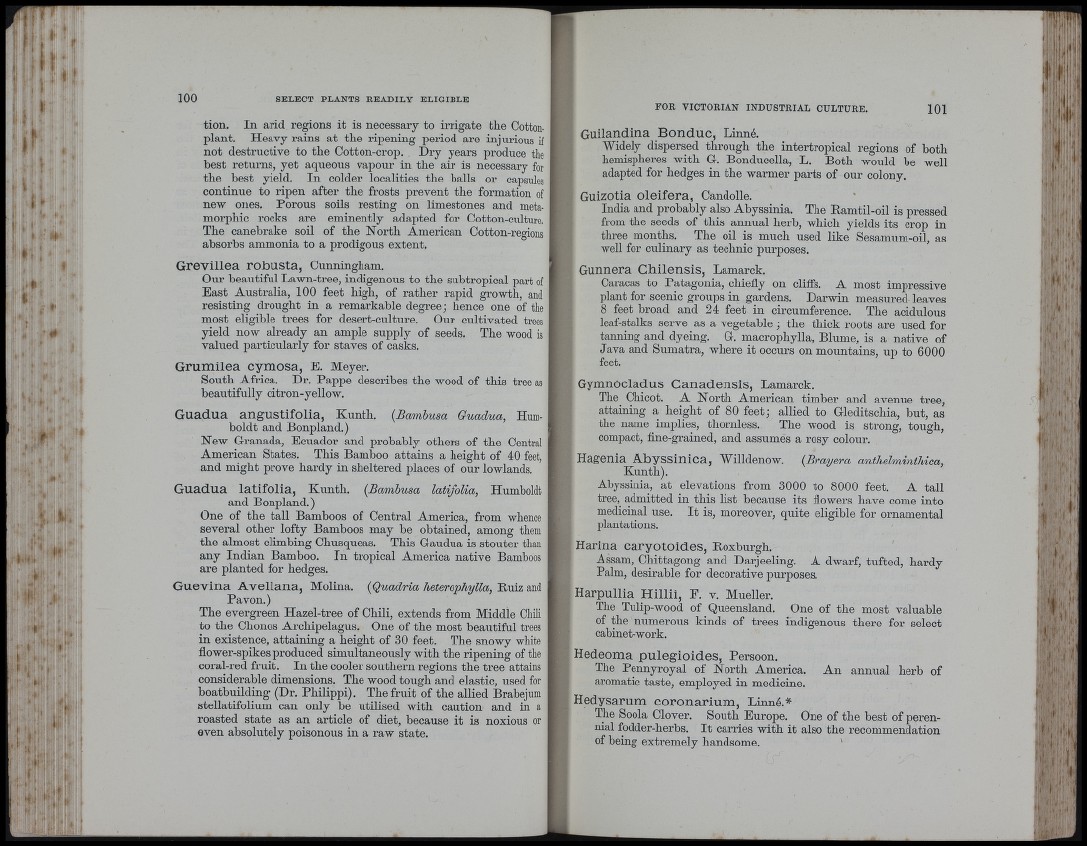
■ÚI á ' i í , , É i i l ^ ;
■ : í í t | :-fi
i ’ ^ t i ’
1 : 1 Mi Ä , «ti' ■'»'■ ■ I
I ■ ' i: r , li
I . U '
m ,.1 , ' M '
!¡ j' ' ■ .: I' #,■. iit:i' ¡";: - |; . ^ ,ii,¡ 'é:
ít' f 1 ':P r '!■■ ■
'Di‘ ■ . r pf H¡r '‘ r:'
fi . "■
. •)
Kii
1 rli.
.’ ■»
100 SELECT PLANTS READILY ELIGIBLE
tion. In arid regions it is necessary to irrigate fclie Cotton-
plant. Heavy rains at the ripening period are injurious if
not destructive to the Cotton-crop. Dry years produce the
best returns, yet aqueous vapour in the air is necessary for
tbe best yield. In colder localities the balls or capsules
continue to ripen after the frosts prevent the formation of
new ones. Porous soils resting on limestones and meta-
morphic rocks are eminently adapted for Cotton-culture,
The canebrake soil of tbe North American Cotton-regions
absorbs ammonia to a prodigous extent.
Grevillea robusta, Cunningham.
Our beautiful Lawn-tree, indigenous to the subtropical part of
East Australia, 100 feet high, of rather rapid growth, and
resisting drought in a remarkable degree; hence one of the
most eligible trees for desert-culture. Our cultivated trees
yield now already an ample supply of seeds. The wood is
valued particularly for staves of casks.
Grumilea cymosa, E. Meyer.
South Africa. Dr. Pappe describes the wood of this tree as
beautifully citron-yellow.
Guadua angustifolia, Kuntb. {Bambusa Guadua, Humboldt
and Bonpland.)
New Granada, Ecuador and probably others of the Central
American States. This Bamboo attains a height of 40 feet,
and might prove hardy in sheltered places of our lowlands.
Guadua latifolia, Kunth. {Bambusa latifolia, Humboldt
and Bonpland.)
One of the tall Bamboos of Central America, from whence
several other lofty Bamboos may be obtained, among them
tbe almost climbing Cbusqueas. This Gaudua is stouter than
any Indian Bamboo. In tropical America native Bamboos
are planted for hedges.
GuGVina Avellana, Molina. {Quadria heterophylla, Buiz and
Pavon.)
The evergreen Hazel-tree of Chili, extends from Middle Chili
to the Chonos Archipelagus. One of the most beautiful trees
in existence, attaining a height of 30 feet. The snowy white
flower-spikes produced simultaneously with the ripening of the
coral-red fruit. In the cooler southern regions the tree attains
considerable dimensions. The wood tough and elastic, used for
boatbuilding- (Dr. Philippi). The fruit of the allied Brabejum
stellatifolium can only be utilised with caution and in a
roasted state as an article of diet, because it is noxious or
even absolutely poisonous in a raw state.
FOR VICTORIAN INDUSTRIAL CULTURE. 101
Guilandina Bonduc, Linné.
Widely dispersed through the intertropical regions of both
hemispheres with G. Bonducella, L. Both would be well
adapted for hedges in the warmer parts of our colony.
Guizotia oleífera, Candolle.
India and probably also Abyssinia. The Bamtil-oil is pressed
from the seeds of this annual herb, which yields its crop in
three months. The oil is much used like Sesamum-oil, as
well for culinary as technic purposes.
Gunnera Chilensis, Lamarck.
Caracas to Patagonia, chiefly on cliffs. A most impressive
plant for scenic groups in gardens. Darwin measured leaves
8 feet broad and 24 feet in circumference. The acidulous
leal-stalks serve as a vegetable; the thick roots are used for
tanning and dyeing. G. macrophylla, Blume, is a native of
Java and Sumatra, where it occurs on mountains, up to 6000
feet.
Gymnocladus Canadensis, Lamarck.
The Chicot. A North American timber and avenue tree,
attaining a height of 80 feet; allied to Gleditschia, but, as
the name implies, thornless. The wood is strong, tough,
compact, fine-grained, and assumes a rosy colour.
Hagenia Abyssinica, Willdenow. {Brayera anthelminthica,
Knnth).
Abyssinia, at elevations from 3000 to 8000 feet. A tall
tree,^ admitted in this list because its flowers have come into
medicinal use. I t is, moreover, quite eligible for ornamental
plantations.
Harina caryotoides, Boxburgb.
Assam, Chittagong and Darjeeling. A dwarf, tufted, hardy
Palm, desirable for decorative purposes.
Harpullia Hillii, F. v. Mueller.
The Tulip-wood of Queensland. One of the most valuable
of the numerous kinds of trees indigenous there for select
cabinet-work.
Hedeoma pulegioides, Persoon.
The Pennyroyal of North America. An annual herb of
aromatic taste, employed in medicine.
Hedysarum coronarium, Linné.*
The Soola Clover. South Europe. One of the best of perennial
fodder-herbs. I t carries with it also the recommendation
of being extremely handsome. '
J\
M
Í I
iAt ' '